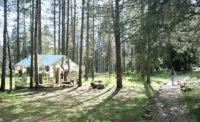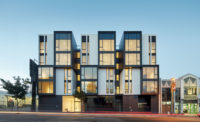Design Vanguard 2017: FreelandBuck
Los Angeles and Brooklyn, New York

Hungry Man
Matching the lighthearted character of the production company, FreelandBuck created a series of “tumbled” office cubicles that playfully challenge the gridded regularity of the typical office space and take advantage of the generous ceiling height.
Photo © Eric Staudenmaier

Stack House
This residential project features a loose pile of rotated boxes on a steeply sloping site in the San Rafael Hills. A corner of each box is removed to knit the rooms together.
Photo © Nelson Garrdio

Stack House
This residential project features a loose pile of rotated boxes on a steeply sloping site in the San Rafael Hills. A corner of each box is removed to knit the rooms together.
Photo © Nelson Garrdio

Parallax Gap
This winning proposal for the Smithsonian’s “Above the Renwick” competition is an assemblage in the Renwick Gallery that represents an eclectic selection of 19thcentury ceiling designs rendered through 21st-century technology and visual culture.
Photo © Kevin Kunstadt

B+F Sahara
FreelandBuck’s continuing research into lamella structures, explored through a series of projects for Gastronomica Restaurant Group, is deployed in this Kuwait City eatery as a vaguely arboreal canopy over the dining room.
Photo © Nelson Garrido





Architects & Firms
Momentum is building for FreelandBuck, founded in 2010 by David Freeland, 40, based in Los Angeles, and Brennan Buck, 42, who heads the firm’s East Coast outpost in Brooklyn. The past two years have been the busiest yet for the duo, who first met in a “difficult sites” workshop during grad school at the University of California, Los Angeles.
An ongoing installation at the Smithsonian’s Renwick Gallery, on view through February 11, 2018, has raised their profile considerably. Parallax Gap is a 10,000-square-foot fabric composition of 19th-century ceiling designs, cut on a CNC machine, stretched over aluminum frames and hung in layers from the ceiling of the museum’s Grand Salon, producing shifting views as visitors walk beneath it. “That work belongs neither to the architectural realm nor to art—it’s up for debate,” Freeland says. “We make architecture, but we spend a lot of time thinking about art,” adds Buck. “Parallax Gap was about trying to make a drawing in three dimensions.” Most recently, the firm was selected as a finalist for MoMA P.S. 1’s Young Architects Program 2018 installation.

All FreelandBuck projects evince an abiding interest in cellular structure and graphic patterns. Their design for Paradise Plaza in the Miami Design District, slated to open this month, stitches together multiple building facades and circulation elements with a dining space under a canopy of vividly colored triangular facets inspired by the work of Israeli sculptor Yaacov Agam.
Three residential projects in the Los Angeles area are also steaming toward completion: the 1,500- square-foot Second House, made up of three distinct, wedge-shaped volumes around an interior courtyard; Stack House, a loose pile of rotated boxes on a steeply sloping site; and Mountain View House, an expansion of a 1920s Craftsman house, with two new shed roofs rotated at 45 degrees, producing a dramatic increase in interior ceiling height. “We love doing stand-alone work, but it was an interesting challenge to work within the constraints of an existing type and still be inventive,” Freeland says.
In the firm’s recent design for the offices of Hungry Man, a Los Angeles video production company, the “cells” are cubes that look “kind of strewn,” as Freeland puts it, across the floor of an existing warehouse, though in fact they are carefully calibrated to facilitate connections between users.
That Freeland and Buck are architects for the future was especially evident in their 2016 proposal for a temporary installation at the base of New York’s Flatiron Building, reimagining the iconic structure as a collection of fractured views printed on layers of translucent fabric. “There’s no longer a single privileged point of view from which we look at buildings, but a plethora,” Freeland says of the new ease of photographing buildings and posting images to be consumed by others.
“We think about form as a way to produce programmatic opportunity, possibility, and variety,” Buck says. While he and Freeland are both glad to expound on conceptual theory, and do so in their teaching positions at Yale and SCI-Arc, respectively, their architecture-making boils down to one essential thing. “What we are interested in,” says Buck, “is how people engage with our buildings.”
FreelandBuck
FOUNDED: 2010
DESIGN STAFF: 6
PRINCIPALS: David Freeland and Brennan Buck
EDUCATION: Freeland: University of California, Los Angeles, M.Arch., 2004; University of Virginia, B.S. Arch., 1999. Buck: University of California, Los Angeles, M.Arch., 2004; Cornell University, B.S. LArch., 1997
WORK HISTORY: Freeland: Michael Maltzan Architecture, 2005–07; Roger Sherman Architecture and Urban Design, 2005; AGPS Architecture, 2004–05; Resolution: 4 Architecture, 1999- 2002; Peter Eisenman Architects, 1998. Buck: Neil M. Denari Architects, 2004; Johnston Marklee & Associates, 2002; Walker Macy Landscape Architecture, 1999-2001
KEY COMPLETED PROJECTS: Parallax Gap, Washington, D.C., 2017; Hungry Man Productions, Culver City, CA, 2017; Nike SF, retail installation, San Francisco, 2013; Earl’s Gourmet Grub, Los Angeles, 2010
KEY CURRENT PROJECTS: Paradise Plaza, Miami; Stack House, Mt. Wash- ington, CA; Urban Putt, miniature golf course, Los Angeles; Second House, Culver City, CA



